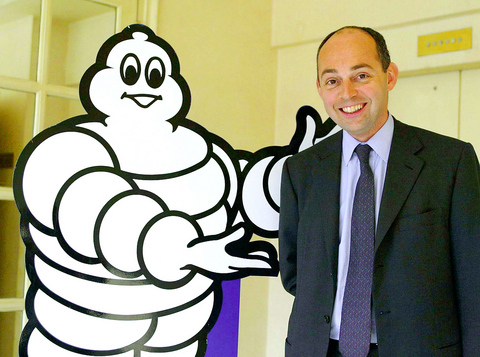Edouard Michelin, who modernized the Michelin tire giant founded more than 100 years ago by his great-grandfather and his great-great uncle, was killed on Friday in a boating accident, the French company said. He was 42.
The world's leading tire maker said Michelin, its co-managing partner who had headed the group since 1999, was killed near Sein island off western France's Atlantic coast.
Michelin joined the company in 1985, nearly a century after it was founded in 1889 by the brothers Edouard and Andre Michelin.

PHOTO: EPA
As boss, he sparked anger by cutting jobs, oversaw Michelin's return to Formula One as well as its planned withdrawal from the sport this year, and brought a new degree of openness to the traditionally paternalistic and secretive company.
Following his death, Michelin said its other managing partner, Michel Rollier, would run the company that employs 130,000 people worldwide, 30,000 of them in France.
The company is also known for its famed restaurant guides, its maps, for inventing radial tires, and for its roly-poly Michelin Man logo, known as Bibendum.
Michelin had been aboard a fishing boat, Le Liberte, that sank in still unexplained circumstances.
The boat left the Brittany port of Audierne on Thursday night. His body was recovered on Friday afternoon, authorities said.
There had been fog on Friday morning, but otherwise conditions were described as excellent. Michelin's fishing companion, Guillaume Normant, was still missing.
Born in Clermont-Ferrand, central France, where the company is based, Michelin trained as an engineer and did his military service in the French Navy.
At Michelin, he held various posts in research, production and sales. He was a factory production manager before becoming CEO of Michelin North America.
He became a managing partner in 1991, and was appointed Michelin's head on June 11, 1999.
The youngest of four sons, he took over from his father, Francois Michelin, becoming the fourth consecutive family member to run the company.
He quickly provoked outcry by announcing 7,500 job cuts -- about 10 percent of Michelin's European workforce -- despite higher profits. The then-Socialist government, unions and even Clermont-Ferrand's bishop were critical.
Michelin took the company back into Formula One in 2001, after a 17-year absence.
"It's going to be challenge and, at Michelin, we love challenges," he said.
But last December, after a fiasco at the US Grand Prix when all Michelin-shod teams sat out the race with concerns over tire safety, the company announced that it would depart F1 after the 2006 season, leaving Japanese builder Bridgestone as the sport's only tire supplier.
French President Jacques Chirac hailed Michelin for modernizing the firm, "making it a universally recognized French industrial champion."
Chirac's Interior Minister and presidential hopeful Nicolas Sarkozy described Michelin, who was married with six children, as "a brilliant, dynamic and deeply humane man."
"He nurtured a passion for his company and knew how to share it," Sarkozy said. "With his death, the French economy tragically loses one of its rising figures."
Michelin reported a 36-percent surge in net profit -- to 889 million euro (US$1.1 billion) -- for last year, despite sharply rising raw material costs and lower volume sales.
The company said on Friday evening that funeral arrangements were not yet fixed. It refused to release the names of his wife and children.

Taiwan Semiconductor Manufacturing Co (TSMC, 台積電) last week recorded an increase in the number of shareholders to the highest in almost eight months, despite its share price falling 3.38 percent from the previous week, Taiwan Stock Exchange data released on Saturday showed. As of Friday, TSMC had 1.88 million shareholders, the most since the week of April 25 and an increase of 31,870 from the previous week, the data showed. The number of shareholders jumped despite a drop of NT$50 (US$1.59), or 3.38 percent, in TSMC’s share price from a week earlier to NT$1,430, as investors took profits from their earlier gains

In a high-security Shenzhen laboratory, Chinese scientists have built what Washington has spent years trying to prevent: a prototype of a machine capable of producing the cutting-edge semiconductor chips that power artificial intelligence (AI), smartphones and weapons central to Western military dominance, Reuters has learned. Completed early this year and undergoing testing, the prototype fills nearly an entire factory floor. It was built by a team of former engineers from Dutch semiconductor giant ASML who reverse-engineered the company’s extreme ultraviolet lithography (EUV) machines, according to two people with knowledge of the project. EUV machines sit at the heart of a technological Cold

Taiwan’s long-term economic competitiveness will hinge not only on national champions like Taiwan Semiconductor Manufacturing Co. (TSMC, 台積電) but also on the widespread adoption of artificial intelligence (AI) and other emerging technologies, a US-based scholar has said. At a lecture in Taipei on Tuesday, Jeffrey Ding, assistant professor of political science at the George Washington University and author of "Technology and the Rise of Great Powers," argued that historical experience shows that general-purpose technologies (GPTs) — such as electricity, computers and now AI — shape long-term economic advantages through their diffusion across the broader economy. "What really matters is not who pioneers

TAIWAN VALUE CHAIN: Foxtron is to fully own Luxgen following the transaction and it plans to launch a new electric model, the Foxtron Bria, in Taiwan next year Yulon Motor Co (裕隆汽車) yesterday said that its board of directors approved the disposal of its electric vehicle (EV) unit, Luxgen Motor Co (納智捷汽車), to Foxtron Vehicle Technologies Co (鴻華先進) for NT$787.6 million (US$24.98 million). Foxtron, a half-half joint venture between Yulon affiliate Hua-Chuang Automobile Information Technical Center Co (華創車電) and Hon Hai Precision Industry Co (鴻海精密), expects to wrap up the deal in the first quarter of next year. Foxtron would fully own Luxgen following the transaction, including five car distributing companies, outlets and all employees. The deal is subject to the approval of the Fair Trade Commission, Foxtron said. “Foxtron will be